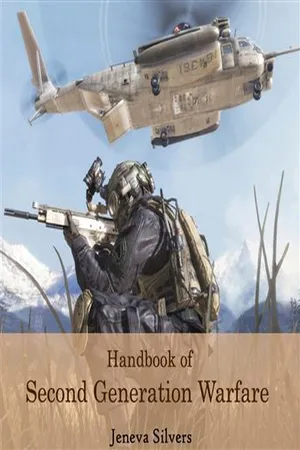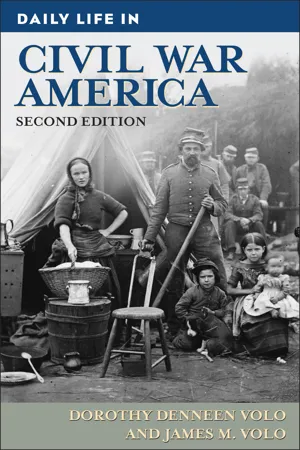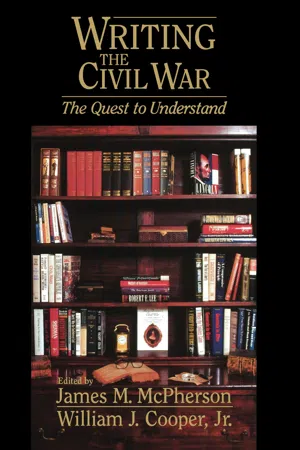History
Goals of the Civil War
The goals of the Civil War in the United States were primarily centered around the issue of slavery and the preservation of the Union. The Union sought to maintain the unity of the country and abolish slavery, while the Confederacy aimed to protect states' rights and preserve the institution of slavery. Ultimately, the war resulted in the abolition of slavery and the reunification of the nation.
Written by Perlego with AI-assistance
Related key terms
1 of 5
6 Key excerpts on "Goals of the Civil War"
- eBook - PDF
- Keith D. Dickson(Author)
- 2022(Publication Date)
- For Dummies(Publisher)
1 The War and Its Causes IN THIS PART . . . Get a handle on the conditions that were shaping the United States and causing trouble. Figure out what a civil war is. War! War! War! So much goes into starting one. CHAPTER 1 How Did the War Happen? 9 Chapter 1 How Did the War Happen? S ince the founding of the United States, different sections of the country had interests and priorities that competed with the interests and priorities of other sections. These conflicts had always been resolved through politics (usually some form of congressional dealmaking). However, beginning in the 1850s, the political process for resolving these disputes became less and less effective. The differences between sections of the country were so great at that time that the survival of the union of states was in danger. Peace depended upon compromise and conciliation between congressional leaders representing each section. This chapter examines the sectional differences between the North and South that led to such a dangerous situation and provides some background to the controversies that led to the Civil War. The Big Picture: War and Politics Wars have many causes. No one should ever forget that wars are fought for politi -cal reasons and objectives. Essentially, people or nations go to war to protect a vital interest, to defend territory from an aggressor, or to achieve a moral purpose (such as defending the innocent and punishing an evil). The Civil War included all IN THIS CHAPTER » Taking a look at the big picture » Defining a “civil war” » Understanding the distinction between North and South » Exploring the issues 10 PART 1 The War and Its Causes of these rationales. Each side used all three justifications for fighting the other during the four years of war. And, interestingly enough, each side had a strong, valid, substantial reason for doing so. What’s a civil war? You hear the word civil in such terms as civil rights, civilian, and civil liberty. - eBook - PDF
Race in the American South
From Slavery to Civil Rights
- David Brown, Clive Webb(Authors)
- 2007(Publication Date)
- Edinburgh University Press(Publisher)
Chapter 6 A FRAGILE FREEDOM: THE CIVIL WAR AND THE COLLAPSE OF SLAVERY ∑ When Abraham Lincoln said in 1858 that ‘a house divided against itself cannot stand’, he expressed a widespread feeling that slavery and freedom could not continue to co-exist within the United States. 1 This did not make war inevitable – specific circumstances in 1860–61 triggered the secession of southern states. Even though numerous factors have been cited, however, very few professional historians would deny that slavery was the root cause of the American Civil War. The political problem posed by slavery in the ante-bellum period caused profound disagreements which eventually became insurmountable. Moderates in both the North and the South struggled des-perately to hold the Union together in the 1850s, but with Abraham Lincoln’s victory in the presidential election of 1860 that no longer seemed possible. Slavery would also be critical to the conduct of the war, even though emancipation was not an official Union policy until well after the start of hos-tilities in April 1861. Modern warfare relied as much on industrial might as it did on soldiers in the field, and the distinctive agrarian character of the South placed it at a huge disadvantage in comparison with the North. Nonetheless, the South tried to make the best of what it had and bondspeople were put to many different tasks by the Confederates. In order to defeat the Confederacy, it became essential to destroy slavery. Secession was undertaken in order to protect slavery from the perceived threat of Lincoln’s Republican Party, but ironically it eventually brought the destruction of the peculiar institution. The exigencies of four years of gruelling warfare placed a tremendous strain on southerners, testing the limits of social consensus as class and gender fault lines emerged prominently and divisively. - No longer available |Learn more
- (Author)
- 2014(Publication Date)
- University Publications(Publisher)
Confederate resistance ended after Lee surrendered to Grant at Appomattox Court House on April 9, 1865. The American Civil War was one of the earliest true industrial wars. Railroads, the telegraph, steamships, and mass-produced weapons were employed extensively. The practices of total war, developed by Sherman in Georgia, and of trench warfare around Petersburg foreshadowed World War I in Europe. It remains the deadliest war in American history, resulting in the deaths of 620,000 soldiers and an undetermined number of civilian casualties. Ten percent of all Northern males 20–45 years of age died, as did 30 percent of all Southern white males aged 18–40. Victory for the North meant the end of the Confederacy and of slavery in the United States, and strengthened the role of the federal government. The social, political, economic and racial issues of the war decisively shaped the reconstruction era that lasted to 1877. Causes of secession The Abolitionist movement in the United States had roots in the Declaration of Independence. Slavery was banned in the Northwest Territory with the Northwest Ordinance of 1787. By 1804 all the Northern states had passed laws to abolish slavery. Congress banned the African slave-trade in 1808, although slavery grew in new states in the deep south. The Union was divided along the Mason Dixon Line into the North (free of slaves), and the South, where slavery remained legal. Despite compromises in 1820 and 1850, the slavery issues exploded in the 1850s. Lincoln did not propose federal laws against slavery where it already existed, but he had, in his 1858 House Divided Speech, expressed a desire to arrest the further spread of it, and place it where the public mind shall rest in the belief that it is in the course of ultimate extinction. Much of the political battle in the 1850s focused on the expansion of slavery into the newly created territories. Both North and South assumed that if slavery could not expand it would wither and die. - eBook - PDF
- Dorothy Volo, James M. Volo(Authors)
- 2009(Publication Date)
- Greenwood(Publisher)
History, Politics, and Slavery Part I The Historian’s War 1 “An irrepressible conflict between opposing and enduring forces.” —William H. Seward 19TH-CENTURY AMERICA At the outbreak of the war, all but the most astute observers thought that the question of national unity would be settled in a single afternoon of combat. But in the first great battle of the war, the intrinsic drama of Amer- icans locked in mortal combat diverted everyone’s attention from the fact that indecisiveness had crept into warfare over the centuries. From 1861 to 1865, Yankees were “bushwhacked” in western Virginia and Rebels were “sniped at” near Washington. Federal “Red Legs” and Confederate “Par- tisans” mauled one another across the plains of Kansas and Missouri and were held in contempt by the politicians on both sides. Simultaneously, giant armies trudged across Northern Virginia, Louisi- ana, and middle Tennessee in efforts to either defend or dismantle the Old South and its characteristic lifestyle. The war policies of both governments so extended into the lives of the local populations that people came to look seriously upon the result as “the hard hand of war.” Meanwhile, the ter- rible cost of war, measured in thousands of lives, afflicted the North with such a palpable weariness that Abraham Lincoln despaired of winning reelection in 1864. He began to lay plans for turning the federal govern- ment over to a successor who would end the war by simply declaring it finished. 1 4 Daily Life in Civil War America The Battle of Gettysburg, the bloodiest ever fought on the North Ameri- can continent, has long been a focal point of Civil War historians. Taken with the simultaneous fall of Vicksburg, the Confederate stronghold on the Mississippi, the federal victory at Gettysburg should have been one of the most decisive military actions in history. Yet the internecine struggle continued, seemingly powered by the undiminished will of the Southern people to prevail. - eBook - PDF
Writing the Civil War
The Quest to Understand
- James M. McPherson, William J. Cooper, James M. McPherson, William J. Cooper, Jr.(Authors)
- 2021(Publication Date)
- University of South Carolina Press(Publisher)
42 As late as 1985, after a least two decades of fruitful, stimulating, and occasionally contentious work in social history, Olivier Zunz lamented that an analysis of the greatest conflict and major crisis of identity expe-rienced by the United States, ... the Civil War, still eludes social historians. Only the social history of the conflict itself, Zunz added, the identifi-cation of the roles social groups played in it-will permit us to balance the search for causes with the search for consequences, and to assess the impact of the war on social change and on the formation of a more uni-fied nation. Four years later Maris Vinovskis was still noting that social historians had on the whole lost the Civil War, and often didn't know where to find it. 43 But Zunz's and Vinovskis's calls have produced little attention by so-cial historians to the North and the war. Vinovskis edited a fine collection of essays containing work on enlistments, support for the war in two New Hampshire towns, soldiers and the values of their communities, re-lief work in Philadelphia, Chicago politics, membership in the GAR, and the impact of the war on widows. But that volume has still not inspired much further work. The fact remains that except for work on race and gender, social historians have shown an abiding lack of interest in finding the war. 44 One sign of that lack of interest appeared when Peter Stearns, editor of the 1994 Encyclopedia of Social History (New York and London: Gar-land), chose a graduate student to write the entry on the social history of the Civil War. Two of the four books that Timothy Haggerty cited at the end of his article were works in traditional history: James M. McPherson's narrative history of the war, Battle Cry of Freedom, and Daniel Sutherland's, Expansion of Every Day Life. Only two were clearly what modern scholars would consider social history: Gerald Linderman, Em-battled Courage: The Experience of Combat in the American Civil War 192 - eBook - PDF
Secession as an International Phenomenon
From America's Civil War to Contemporary Separatist Movements
- Don Doyle(Author)
- 2010(Publication Date)
- University of Georgia Press(Publisher)
The northern response to this challenge has frequently taken second place in the literature to an interest in the development of southern, or Confeder-ate, nationalism; historians have been far more interested in why the South se-ceded and whether by that process a separate nation was created than in why the North sought to prevent secession and how by that process a single nation was sustained. Hindsight is part of the problem here, but historians’ fascination with the perceived underdog, the lack of appreciation of the development of a specifically northern nationalism against which southern nationalism devel-oped in the first place, and the sense of the South as a region persistently dif-ferent from if not at odds with the rest of the United States have all contributed to a large literature on the subject of white southern support for secession and a concomitant dearth of material on northern opposition to it. The American Civil War was a war of state formation, yet when the war came many of the most influential bodies with respect to propaganda and support were private concerns, not state ones. Northern elite organizations such as the Loyal Publication Society of New York had the self-appointed task of both pro-mulgating their own perspective on American nationalism and interpreting and disseminating the Lincoln administration’s position on secession in support of that nationalism: in the denial of secession a nation was finally conceived but not yet born. It would take a military victory to confirm America’s “new birth of freedom,” and for that, the morale of the people was a crucial component. In successfully meeting the challenge of how to conduct, and win, a long war, the people established beyond doubt the legitimacy of the American federal system as a constitutionally validated perpetual union.
Index pages curate the most relevant extracts from our library of academic textbooks. They’ve been created using an in-house natural language model (NLM), each adding context and meaning to key research topics.





